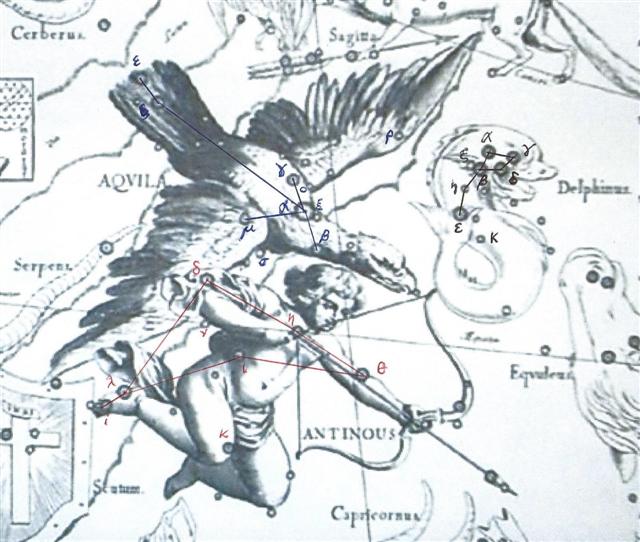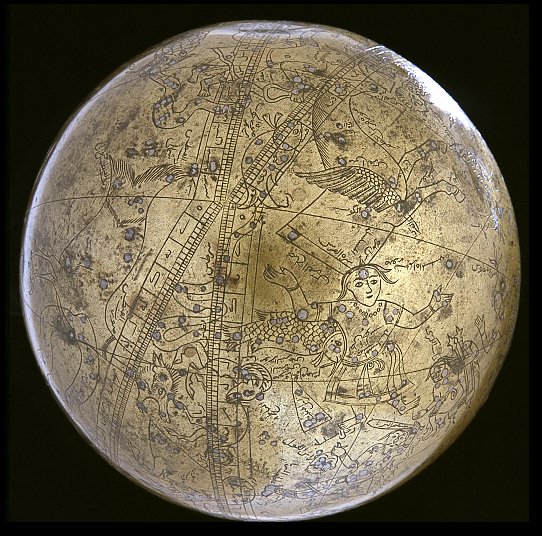Allen: "Two of the Arabic globes bear the stars δ, θ, κ, and λ Aquilae, which mark the distinguishing rhombus of Antinoüs, as Thalīmain, the Two Ostriches; but Ideler assigned this title to ι and λ; giving δ,η, and θ as Al Mīzān, the Scale-beam.
Simone Assemani said that they were Alkhalimain, that more correctly is Al Halīlain, the Two Friends, or Al Halimatain, the Two Papillae; but his assertions as to star-names are often unfavorably criticized by Ideler as 'a confused medley, raked together without criticism.' These globes are so frequently referred to as indicative of the character and progress of the astronomy of Arabia, that I may be pardoned a brief digression as to them. One, of the year 1225, now rests in the museum established by the Cardinal Borgia at Villetri; another, of 1289, is in the Mathematical Salon at Dresden; Mr. A. V. Newton claims the early date of the 11th century for one lettered in Arabo-Cufic characters, now in the Bibliothèque Nationale of Paris, as does Signor F. Meucci for one in Florence; another, of bronze, from Arabian times, the stars lettered in silver, but not figured, is in the rooms of the Royal Astronomical Society of London; and the Emperor Frederick II of Italy, in the 13th century, is said to have had one of gold, the stars being shown by inlaid pearls. All these seem to have been of comparatively small dimensions, five to eight inches in diameter, a great contrast to the six-foot globe of Tycho Brahe, now in the castle at Prague. Those of Mercator were about sixteen inches. But celestial globes were known long anterior to these. One that is considered very correct as to the location of the early constellations, although it does not show the individual stars, is in the Farnese collection of antiquities, surmounting the statue of Atlas.
This globe, supposed to be a copy of the sphere of Eudoxos, and perhaps antedating Ptolemy, although somewhat defaced, has preserved to us a more than forty of the sky figures of its day; while another, of brass, said to have been constructed by Ptolemy himself, - doubtless an apocryphal statement, - was found in 1043 in an old public library in Kahira, the modern Cairo. Ptolemy described the globe of Hipparchos that is illustrated in Halma's edition of the Syntaxis, published with a French translation in Paris in 1813-16; Eudoxos is said to have constructed one 366 B.C., as did Anaximander of Miletus 584 B.C. The actual invention of celestial globes has been credited to Thales, as the mythical was to Atlas; but Flammarion nearly rivals this last when he seriously tells us of Chiron's sphere - 'the most ancient sphere known, constructed about the epoch of the Trojan War, 1300 B.C.'; and Sir Isaac Newton, induced by an incorrect translation from Diogenes Laertius, asserted that Musaeus, on of the Argo's crew, was the first to make a celestial sphere, on which he located the ship and many others of the Greek constellations derived from the story and characters of the Argonauts."
"Muhammad Salih Tahtawi of Sindh headed the task of creating a massive, seamless celestial globe using a secret wax casting method in the Mughal Empire, the famous celestial globe of Muhammad Salih Tahtawi is inscribed with Arabic and Persian inscriptions and was completed in the year 1631 during the reign of the Mughal Emperor Jahangir." (Wikipedia)
... The old man gave the Raven two small sticks, like gambling sticks, one black, one multicoloured. He gave him instructions to bite them apart in a certain way and told him to spit the pieces at one another on the surface of the sea. The Raven climbed back up the pole, where he promptly did things backwards, just to see if something interesting would occur, and the pieces bounced apart. It may well be some bits were lost. But when he gathered what he could and tried again - and this time followed the instructions he had been given - the pieces stuck and rumpled and grew to become the mainland and Haida Gwaii. On the Mughal celestial globe above we can see that the measuring 'sticks' are not crossing each other, they are instead 'bouncing apart'. The time was wrong because the back quarter of Pegasus was not available and Andromeda had turned her head away. | ||||||||||||||||



